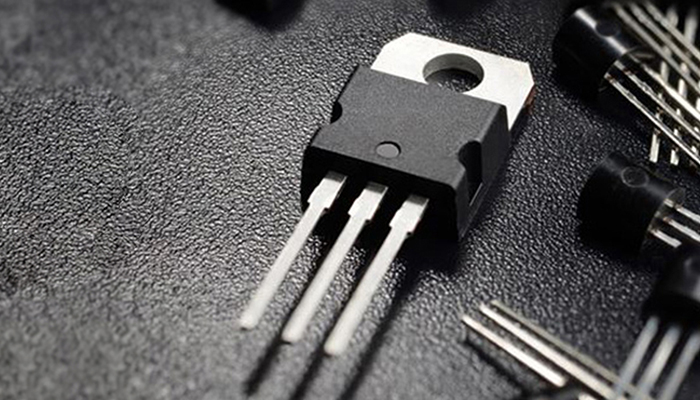Topdiode PDC3301D5 is an uni-directional TVS diode, utilizing leading monolithic silicon technology to provide fast response time and ultra low ESD camping voltage, making this device an ideal solution for protecting voltage sensitive data and power line.The PDC3301D5 complies with the lEC 61000-4-2(ESD)with +30kV air and +30kV contact discharge. lt is assembled into an ultra-small SOD-523 lead-free package.The small size and high ESD surge protection make PDC3301D5 an ideal choice to protect cell phone, digital cameras, audio players and many other portable applications.
Dimensions and Pin Configuration
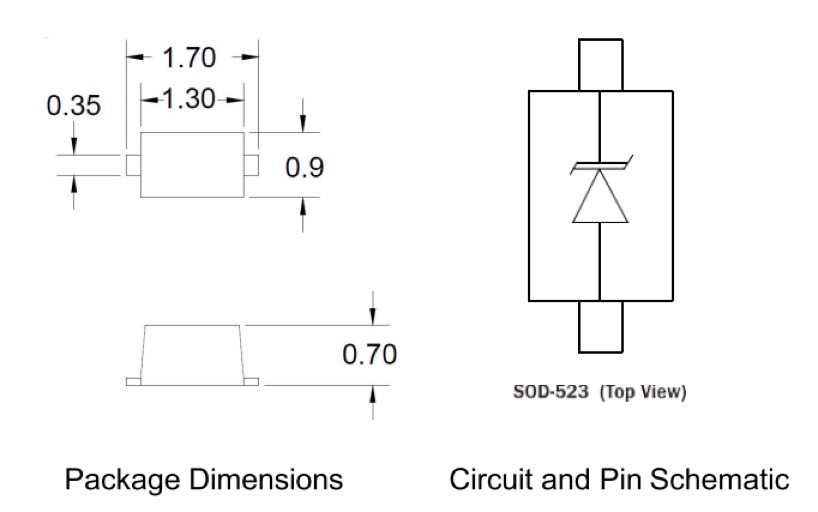
Complies with following standards:
-IEC 61000-4-2 (ESD) immunity test Air discharge: +30kV
Contact discharge: ±30kV
IEC61000-4-4(EFT)40A(5/50ns)
Topdiode PDC3301D5 TVS Diode Use in sensitive electronics protection against voltage transients induced by inductive load switching and lighting on ICs, MOSFET, signal lines of sensor units specifically for protecting 10V supplied sensitive equipment against transient over voltages.
Unidirectional Transient Voltage Suppressor (TVS) diodes offer advantages like cost-effectiveness and efficient protection against voltage spikes in one direction, but they are not suitable for circuits with both positive and negative voltage swings, and they can short out reverse voltages.
Advantages:
Cost-Effective:
Unidirectional TVS diodes are generally less expensive than their bidirectional counterparts.
Efficient Protection:
They effectively clamp voltage transients in one direction, protecting sensitive circuits from damage.
Suitable for DC Circuits:
They are well-suited for protecting circuits where voltage is predominantly in one direction, such as DC circuits.
Lower Clamping Voltage:
In the positive direction, unidirectional TVS diodes can offer a lower clamping voltage compared to bidirectional TVS diodes.
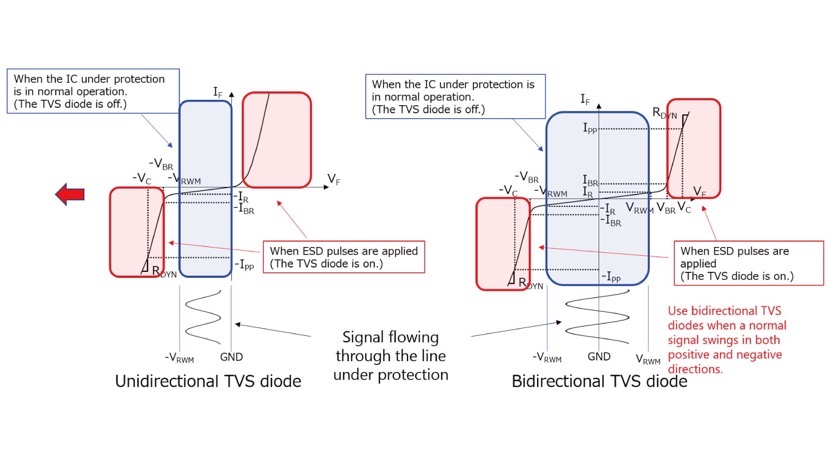
Disadvantages
Limited Protection
They only protect against voltage spikes in one direction, making them unsuitable for circuits with both positive and negative voltage swings.
Reverse Voltage Shorting
In the opposite direction, they behave like a normal diode, potentially short-circuiting reverse voltages, which can be problematic.
Not Ideal for Bipolar Circuits
They are not suitable for protecting bipolar circuits, which require bidirectional protection.
Not Suitable for AC Applications
Unidirectional TVS diodes are not suitable for AC applications where the transient polarity is not predictable.
when only a positive voltage is applied to the signal line to be protected during normal operation, unidirectional TVS diodes can be used to absorb both positive and negative ESD events. When both positive and negative voltage are applied to the signal line to be protected, use bidirectional TVS diodes.
How to choose the correct TVS diode?
Select a TVS diode with a VRWM higher than this voltage. Is the signal line to be protected a single-polarity (either positive or negative) line? Or, is it a dual-polarity line? Use a bidirectional TVS diode for a dual-polarity line.
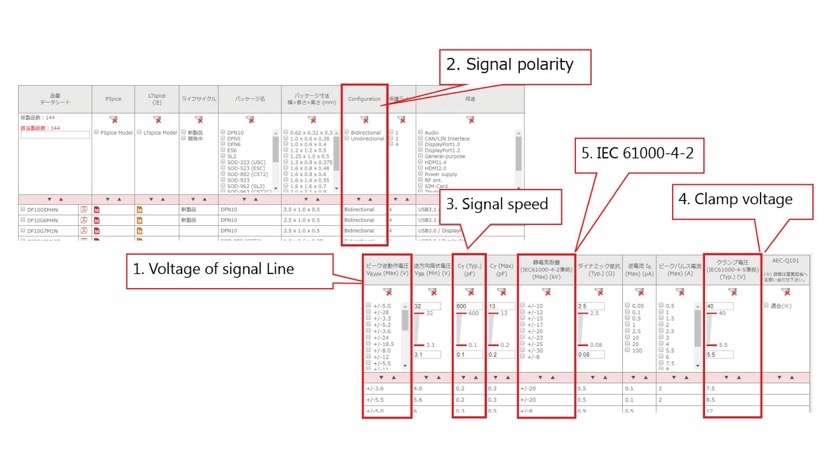
Selection procedure
Voltage of signal Line
What is the maximum voltage of the signal or power line to be protected?
Select a TVS diode with a VRWM higher than this voltage.
Signal polarity
Is the signal line to be protected a single-polarity (either positive or negative) line? Or, is it a dual-polarity line?
Use a bidirectional TVS diode for a dual-polarity line. For a single-polarity line, either a unidirectional or bidirectional TVS diode can be used. However, some unidirectional TVS diodes provide better ESD protection for negative-polarity signals. If an IC is destroyed even in the presence of a TVS diode, consider replacing it with a unidirectional TVS diode.
Signal speed
What is the maximum frequency of the signal line to be protected?
A TVS diode with high total capacitance CT could degrade signal integrity. Select a TVS diode with adequate capacitance according to the signal frequency. Use the following figure as a guide to select a TVS diode with adequate capacitance.
Clamp voltage
To obtain good ESD protection performance, select a TVS diode with the clamp voltage higher than the line voltage.
IEC 61000-4-2
Select a TVS diode with a guaranteed ESD tolerance level higher than the system’s ESD immunity requirement. Note, however, that ESD tolerance of the TVS diode is generally proportional to its total capacitance CT.
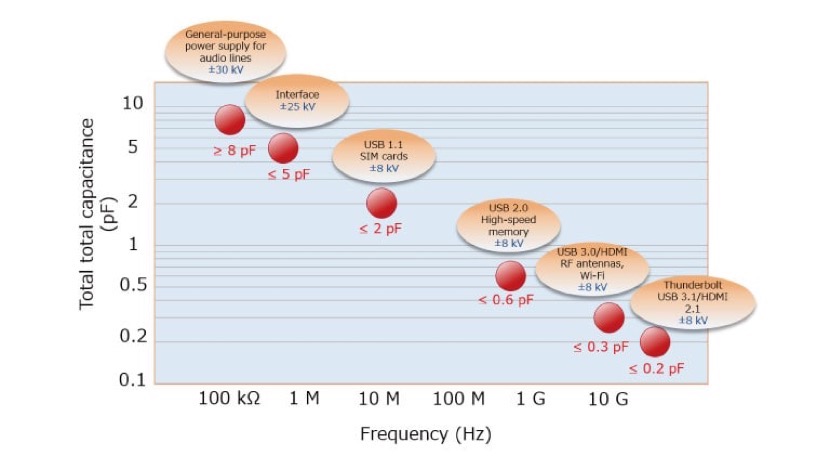
For further question or inquiries, please kindly contact Loie: sales4@topdiode.com, or visit our website: www.topdiodes.com



